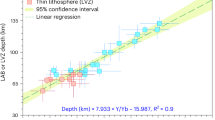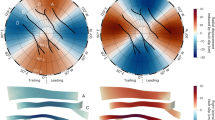Abstract
The Earth’s inner core is structurally complex and its texture as well as the degree of its seismic anisotropy1 varies with depth2. In the modern inner core, an uppermost isotropic layer3,4 surrounds a deeper and more anisotropic region that includes the seismically distinct innermost inner core5,6,7. This structural complexity is probably related to strain resulting from the growth of the inner core8. However, as most dynamic models of anisotropy generation8,9,10,11 have considered only current deformation, how strain evolved through time and influenced texture is not fully understood. Here we use a numerical model to couple preferential crystallization in the equatorial region of the inner core8 with density stratification arising from inner-core growth, allowing both to evolve over the entire history of the inner core. Our results suggest that the inner core evolves gradually from a regime in which deformation penetrates into the deepest parts to a regime in which it is confined to the uppermost region. The deep anisotropy is therefore best understood as a fossil anisotropy inherited from horizontal Maxwell stresses (arising because of the magnetic field)10 or texture formation during solidification12,13,14. The structure of the upper layers, on the other hand, probably results from active tectonics induced by heterogeneous growth of the inner core.
This is a preview of subscription content, access via your institution
Access options
Subscribe to this journal
Receive 12 print issues and online access
$259.00 per year
only $21.58 per issue
Buy this article
- Purchase on Springer Link
- Instant access to full article PDF
Prices may be subject to local taxes which are calculated during checkout


Similar content being viewed by others
References
Poupinet, G., Pillet, R. & Souriau, A. Possible heterogeneity of the Earth’s core deduced from PKIKP travel times. Nature 305, 204–206 (1983).
Souriau, A. in Treatise on Geophysics Vol. 1 (ed. Schubert, G.) (Elsevier, 2007).
Garcia, R. & Souriau, A. Inner core anisotropy and heterogeneity level. Geophys. Res. Lett. 27, 3121–3124 (2000).
Niu, F. L. & Wen, L. X. Hemispherical variations in seismic velocity at the top of the Earth’s inner core. Nature 410, 1081–1084 (2001).
Ishii, M. & Dziewonski, A. M. The innermost inner core of the earth: Evidence for a change in anisotropic behavior at the radius of about 300 km. Proc. Natl Acad. Sci. USA 99, 14026–14030 (2002).
Sun, X. & Song, X. The inner inner core of the Earth: Texturing of iron crystals from three-dimensional seismic anisotropy. Earth Planet. Sci. Lett. 269, 56–65 (2008).
Niu, F. L. & Wen, L. X. Seismic evidence for distinct anisotropy in the innermost inner core. Nature Geosci. 1, 692–696 (2008).
Yoshida, S., Sumita, I. & Kumazawa, M. Growth model of the inner core coupled with the outer core dynamics and the resulting elastic anisotropy. J. Geophys. Res. 101, 28085–28104 (1996).
Jeanloz, R. & Wenk, H.-R. Convection and anisotropy of the inner core. Geophys. Res. Lett. 15, 72–75 (1988).
Karato, S.-I. Seismic anisotropy of the Earth’s inner core resulting from flow induced by Maxwell stresses. Nature 402, 871–873 (1999).
Buffett, B. A. & Wenk, H.-R. Texturing of the Earth’s inner core by Maxwell stresses. Nature 413, 60–63 (2001).
Karato, S.-I. Inner core anisotropy due to the magnetic field-induced preferred orientation of iron. Science 262, 1708–1711 (1993).
Bergman, M. I. Measurements of elastic anisotropy due to solidification texturing and the implications for the Earth’s inner core. Nature 389, 60–63 (1997).
Brito, D., Elbert, D. & Olson, P. Experimental crystallization of gallium: Ultrasonic measurements of elastic anisotropy and implications for the inner core. Phys. Earth Planet. Inter. 129, 325–346 (2002).
Alf è, D., Gillan, M. J. & Price, G. D. Ab initio chemical potentials of solid and liquid solutions and the chemistry of the Earth’s core. J. Chem. Phys. 116, 7127–7136 (2002).
Badro, J. et al. Effect of light elements on the sound velocities in solid iron: Implications for the composition of Earth’s core. Earth Planet. Sci. Lett. 254, 233–238 (2007).
Nimmo, F. in Treatise on Geophysics Vol. 8 (ed. Schubert, G.) (Elsevier, 2007).
Yukutake, T. Implausibility of thermal convection in the Earth’s solid inner core. Phys. Earth Planet. Inter. 108, 1–13 (1998).
Turner, J. S. Buoyancy Effects in Fluids (Cambridge Univ. Press, 1980).
Buffett, B. A. & Bloxham, J. Deformation of Earth’s inner core by electromagnetic forces. Geophys. Res. Lett. 27, 4001–4004 (2000).
Glatzmaier, G. A. & Roberts, P. H. Dynamo theory then and now. Int. J. Eng. Sci. 36, 1325–1338 (1998).
Bergman, M. I., MacLeod-Silberstein, M., Haskel, M., Chandler, B. & Akpan, N. A laboratory model for solidification of Earth’s core. Phys. Earth Planet. Inter. 153, 150–164 (2005).
Aubert, J., Amit, H., Hulot, G. & Olson, P. Thermochemical flows couple the Earth’s inner core growth to mantle heterogeneity. Nature 454, 758–761 (2008).
Labrosse, S., Poirier, J.-P. & Le Mouël, J.-L. The age of the inner core. Earth Planet. Sci. Lett. 190, 111–123 (2001).
Wenk, H.-R., Matthies, S., Hemley, R. J., Mao, H.-K. & Shu, J. The plastic deformation of iron at pressures of the Earth’s inner core. Nature 405, 1044–1047 (2000).
Van Orman, J. A. On the viscosity and creep mechanism of Earth’s inner core. Geophys. Res. Lett. 31, 20606 (2004).
Poirier, J. P. & Price, G. D. Primary slip system of ε-iron and anisotropy of the Earth’s inner core. Phys. Earth Planet. Inter. 110, 147–156 (1999).
Sumita, I. & Olson, P. A laboratory model for convection in Earth’s core driven by a thermally heterogeneous mantle. Science 286, 1547–1549 (1999).
Albarède, F. Introduction to Geochemical Modeling (Cambridge Univ. Press, 1996) (ISBN 0521578043).
Vočadlo, L. in Treatise on Geophysics Vol. 2 (ed. Schubert, G.) (Elsevier, 2007).
Acknowledgements
We would like to thank P. Olson, C. Finlay, N. Arndt, J. Serafini and the Geodynamo group (LGIT, Grenoble) for discussions and comments on this letter. This work was supported by the SEDIT programme of CNRS-INSU.
Author information
Authors and Affiliations
Corresponding author
Supplementary information
Supplementary Information
Supplementary Information (PDF 274 kb)
Rights and permissions
About this article
Cite this article
Deguen, R., Cardin, P. Tectonic history of the Earth’s inner core preserved in its seismic structure. Nature Geosci 2, 419–422 (2009). https://doi.org/10.1038/ngeo522
Received:
Accepted:
Published:
Issue Date:
DOI: https://doi.org/10.1038/ngeo522
This article is cited by
-
Up-to-fivefold reverberating waves through the Earth’s center and distinctly anisotropic innermost inner core
Nature Communications (2023)
-
Enhanced inner core fine-scale heterogeneity towards Earth’s centre
Nature (2023)
-
An initial map of fine-scale heterogeneity in the Earth’s inner core
Nature Geoscience (2022)
-
Equatorial anisotropy in the inner part of Earth’s inner core from autocorrelation of earthquake coda
Nature Geoscience (2015)
-
Melting-induced stratification above the Earth’s inner core due to convective translation
Nature (2010)



